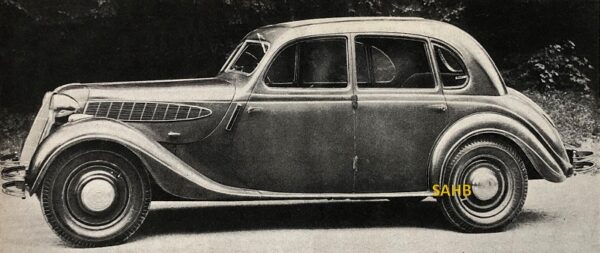
The BMW 328 is surely the most exciting and sought-after BMW of the pre-war era – but the more sober 326 was, in its own way, equally impressive. It was produced by BMW at their Eisenach factory in between 1936 and 1941 and again, briefly, after the war in what had become East Germany. It was BMW’s first four-door saloon; its design was innovative, and it sold well despite its high price. And it formed the inspiration for a famous British car.
It was designed by Fritz Fiedler, with a box-section frame, torsion-bar rear suspension – and hydraulic brakes, a first for BMW. Styling was by Peter Szymanowski, and the 326 was available as a four-door saloon and a two- or four-door cabriolet. The 1,971cc overhead-valve pushrod straight-six engine was derived from that in the 319, with a tiny increase in capacity from 1,911cc in its predecessor. Twin 26 mm Solex carburettors fed the engine, and power output was around 50bhp, for a healthy but not earth-shattering 71mph top speed. The four-speed gearbox had freewheel on the bottom ratios and synchromesh on third and fourth. The 326 was introduced at the Berlin Motor Show in February 1936, and by 1941 15,949 had been built.
The Eisenach factory has fascinating history dating back to 1896, which we only have space to mention briefly here. Heinrich Ehrhardt founded the Fahrzeugfabrik Eisenach to produce bicycles and guns. In 1898 he launched a car, the Wartburg (named after the mediaeval castle at Eisenach), a licensed model of the French Decauville. In 1904 the company was reorganised to build the Dixi, and after building trucks and guns in World War I returned to cars. In 1927 the Dixi became an Austin Seven built under licence. BMW took over production in 1928 and in 1933 built their first six-cylinder car there, the 303.
In 1945 Eisenach was occupied by US forces but was handed over to the Soviets, and a few 326 models were built, updated by 1948 to the BMW 340. These cars were badged BMW, despite the existence of BMW in West Germany. The dispute over the rights to the name was only resolved in 1952 when the East German government took over the factory and the cars were rebadged EMW. So good was the design of the 326, however, that in modernised 340 form it was built in Eisenach until 1955.
And now to the British connection. Frazer Nash had been importing BMWs before the war and badging them Frazer Nash-BMW, and after the war the detailed plans for the 326 were brought to Britain. The Bristol Aeroplane Company transformed the design into the first Bristol car, the 400, using much of the 326 design but fitting a derivative of the 328 engine with cross-pushrods to give a hemispherical head and much more power.
Image courtesy of The Richard Roberts Archive: www.richardrobertsarchive.org.uk







Leave a Comment